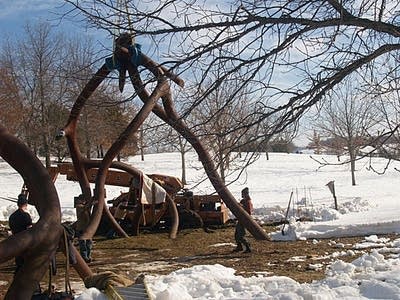Steelroots sculpture show born of many challenges
Go Deeper.
Create an account or log in to save stories.
Like this?
Thanks for liking this story! We have added it to a list of your favorite stories.

"Steelroots: Touching the Earth and Sky" doesn't officially open at the Minnesota Landscape Arboretum in Chanhassen until mid-April. However the 16 sculptures are already in place, and on view. Those who saw the installation learned a lot about sculpture, roots, and how a sudden thaw can ruin a rigger's day.
In late February, just about halfway along the Arboretum's Three Mile Drive, Rick Scolowski had a problem.
"The immediate challenge is the weather," he said. "It's too warm."
Scolowski is the rigger who was trying to install the largest of sculptor Steve Tobin's works. It's a 40-foot-tall representation of a root structure. Made from reclaimed pipeline, it weighs thousands of pounds. It's broken into several pieces for transportation.
Turn Up Your Support
MPR News helps you turn down the noise and build shared understanding. Turn up your support for this public resource and keep trusted journalism accessible to all.
"And we have to squeeze it together because it has to make to fit so perfectly for it to be structurally sound," he said.
Scolowski says he's working with tolerances of fractions of inches.
"Yeah, at the end of a crane," he grins.

Now complicating this jigsaw is a mini thaw. Scolowski needs frozen ground to support the trucks bringing big pieces like this. So as the rest of the Minnesota celebrated a mini-melt, Scolowski's special forklift sank to its axles in mud.
Watching the struggle is the Arboretums Sandy Tanck. She's trying not to worry about the damage the sunken wheels may be doing to the living root structures of the nearby trees.
"We'll have it freed in a half-hour or so," she said. "It's not permanent."
As the Arboretum's manager of interpretation Tanck brought Steve Tobin's Steelroots show to Minnesota. She says the modernist sculptures are a perfect match for the Arboretum's everyday work with plants.
"The root systems are the part that's out of sight and out of mind, and often overlooked," she said, "Yet they are essential for the health of the tree, so to bringing them up onto the surface where we can honor them and contemplate them is interesting in and of itself."
The 16 pieces range from just a few feet tall to the behemoth taking shape before us. Many are finished in glossy paint, in shiny whites and blues. They all twist and fork. Some are simple with just a few offshoots, others branch out in all directions like an inverted bouquet. They are abstract, but primordially recognizable.
Speaking from his home in Pennsylvania Steve Tobin says he had been working in bronze, actually casting real roots. Then one piece changed everything. It's called the Trinity Root.

"It's on the corner of Wall Street and Broadway in New York," Tobin said. "And it's a cast bronze root, about 20 feet, made from the tree that saved the Trinity Church."
It was a sycamore which absorbed the shockwave when the World Trade Center collapsed on 9/11. The force ripped the tree out the ground, but not a single church window broke, even as other nearby buildings crumpled. The church became a gathering place for the Ground Zero workers.
Memorializing the site has been very political, and the Trinity Root is actually the only sculpture near the Ground Zero. It's been visited by millions of people.
Yet Tobin says such was the emotion attached to that piece, he couldn't continue his bronze casting work.

With the Steelroots sculptures he can still explore the shapes, but also work on a much larger scale. And he gets some control over how a sculpture changes the place where it stands.
"It's really a symbiotic relationship between the piece and it's location," he said.
Tobin says humans are biologically programmed to recognize and then dismiss most surroundings. He designs works to become frames through which to view a place. He says this allows people to rediscover their surrounding. The Arboretum's Sandi Tanck agrees.
"They form these passages and portholes and windows so that they are framing the trees and the grass and the sky around them," she said.
Even now when there isn't much foliage the sculptures act like sundials, casting shadows on the snow, which Tobin took into account as he designed them. He says there is five years work in the Steelroots show. He's now looking for ways to make even larger versions, maybe hundreds of feet tall.
Which will mean more challenges for riggers like Rick Scolowski.



